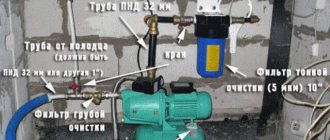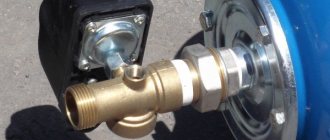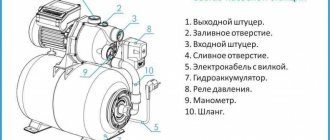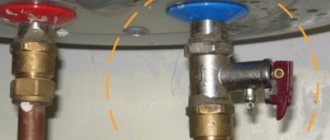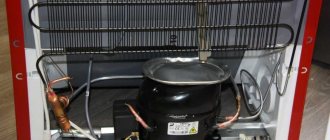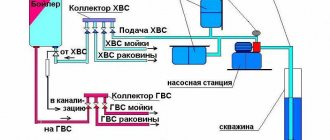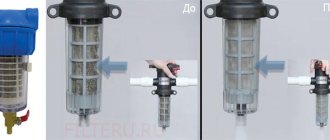When equipping an individual hydraulic extraction point on a site (for example, a well or well), it is also necessary to install a hydraulic accumulator. This is a storage tank with a complex device, an integral part of which is a small device used to measure the liquid level in the storage tank. In the article we will talk about the water pressure switch for a submersible water pump (pumping station) in the water supply system, we will talk about adjusting and configuring the sensor according to the instructions.
Pumping station design
Factory-made pumping stations are fully equipped by the manufacturer and ready for use. Their main purpose is forced water supply. To understand how to set up a pumping station, you need to know its structure.
Such mechanisms operate according to a fairly simple scheme. Inside the accumulator there is an elastic container into which water is supplied using a pump. Filling the tank with water puts pressure on another part of the hydraulic tank filled with air or gas. When the pressure reaches the set values, the pump turns off. Taking water from the storage tank leads to a decrease in pressure in the system and when the minimum value is reached, the pump turns on again.
To turn the pump on and off, the equipment is equipped with a special pressure regulator for the pumping station. The owner can control the pressure level according to the readings of the pressure gauge, also installed on the equipment.
Settings
Sequencing:
- Connect the pressure gauge.
- Turn on the system and note on the device at what values it turns on and off.
- Tighten the nuts on the springs.
- Perform a test run again.
Main table dispenser AquaPro 919H/RO (hot and cold water)
Main table dispenser AquaPro 929CH/RO (cooling/heating)
Floor dispenser AquaPro 311 (empty, without cooling)
This cycle can be performed several times until the most accurate results are obtained.
Main problems and causes
Various factors can damage a household pumping station, including damage to the integrity of the hydraulic tank or pipes, leakage of water or air, and the entry of various impurities into the system.
You can intervene in the operation of the pumping station in the event of problems with its operation in the following cases:
- Sand or other impurities have entered the system. This may cause corrosion and reduced performance. You can prevent clogging of the system by using various filter elements to purify water.
- Reduced air pressure in the system. This phenomenon leads to frequent operation of the pump and a decrease in its service life. Regular measurement of air pressure and setting up a pumping station if necessary helps to avoid such troubles.
- Violation of the tightness of joints in the suction pipeline. As a result, the engine is constantly running, but water is not pumped.
- Incorrect adjustment of the hydrophore causes a lot of inconvenience and can cause a malfunction of the pumping station.
Regular inspection and preventive maintenance ensure the service life of pumping equipment. It is important to remember that before adjusting the pressure at the pumping station, the pumping station must be disconnected from the power supply and the water drained.
Types and varieties
The design may differ from that described above due to other types. All products must first be classified into:
- Mechanical models. Its device is just described above. These are two springs, a movable membrane partition and a block with contacts. It is worth noting such advantages as the stability of the mechanism, as well as its simplicity. And the simpler the design, the less likely it is to break and the easier it is to repair. Therefore, the part can be called quite easy to handle. If there is a “dry running” sensor, that is, a complete shutdown of the equipment in the absence of liquid, then restarting is done manually. It is worth noting that on mechanical water pressure regulators for the pump, precise adjustment is more difficult.
- Electric models. They are distinguished by increased accuracy of values and ease of setup. They have a slightly higher cost. At the core is a flow controller. It is he who transmits the impulse to stop the pumping equipment. An additional advantage is the additional presence of a small hydraulic tank. This fluid supply helps protect the entire installation from water hammer. However, there is also a negative feature - increased sensitivity to impurities. If you install an electric relay, then you must install filters in front of it. Filtration equipment can be ordered from – we supply products for domestic and commercial use.
Another constructive distinction is that the sensor can be:
- Powerful. It carries out the process of activating and switching off the pump.
- Managers. They only transmit information and are also responsible for the operation of the pumping station.
In addition to design features and purpose, all relays can be distinguished by technical indicators:
- according to the maximum achieved pressure in the water utility;
- along the lower similar border;
- according to the volume of the hydraulic accumulator with which the device is compatible;
- by power - this parameter must be correlated with the throughput capacity of the equipment;
- in terms of manufacturer - Russian and Chinese models are not always inferior to European ones, but it is worth highlighting countries of production such as Denmark, Germany, Italy.
Here is a comparison table of popular models:
| Country of Origin | Name | Protection class, IP | Cost, rub. | Lower and upper limits of pressure, atm | Initial setting, atm |
| Italy | Italtecnica РМ/5G (m) 1/4″ | 44 | From 1 900 | 1 –5 | 1,4–2,8 |
| Germany | Grundfos (Condor) MDR 5-5 | 54 | From 3 800 | 1,5 – 5 | 2,8– 4,1 |
| Italy | Italtecnica PT/12 (m) | 44 | From 1900 | 1 –12 | 5 – 7 |
| Spain | Genebre 3781 1/4″ | – | From 500 | 1 – 4 | 0,4 – 2,8 |
| Italy | Italtecnica PM53W 1″ | – | From 500 | 1,5 – 5 | – |
| Russia | RDM-5 Gilex | 44 | From 900 | 1 – 4,6 | 1,4 — 2,8 |
Troubleshooting Methods
Troubleshooting jobs can be simple or complex. In the first case, it is enough to replace the cartridges in the filter and eliminate leaks. The second option involves taking further measures if simple measures do not produce results. In this case, it is important to know how to set up the hydrophore.
More complex troubleshooting steps for pumping equipment include adjusting the pressure in the hydraulic tank and adjusting the pressure switch. In this case, you need to know what pressure should be in the water supply station.
There are several problems with the operation of a household pumping station that you can try to fix yourself.
Deviation from equipment operation requirements
Continuous operation of the equipment, without shutting down, is noted if the automation of the pumping station is configured incorrectly. In particular, we are talking about too high set pressure values. In addition, this occurs when the engine is idling, which is not accompanied by pumping water.
Such a deviation in performance may occur for the following reasons:
- The first start of the pump was carried out without filling with water. To solve the problem, you need to pour water into the pump using a special funnel and adjust the hydrophore.
- The pipeline is damaged or an air lock has formed in the suction valve. Such a problem can only be detected by checking the entire length of the pipeline for bends, narrowings or air pockets. Identified problems should be eliminated and damaged areas replaced.
- There is no access to water for operating equipment. The solution to the problem is to find the reasons for the lack of water and eliminate them.
- Blockage in the pipeline. Simply cleaning the pipeline and removing accumulated contaminants can help fix the problem.
If the station starts working and turns off after a short period of time, then the problem may be a damaged membrane. In this case, the membrane needs to be replaced. A similar situation can occur if there is no necessary pressure in the system. Here you need to take the appropriate measurements and check the hydraulic tank for cracks or other damage.
The situation with blocking the operation of the check valve occurs quite rarely. This occurs when debris or foreign objects enter the system. The situation can be corrected by disassembling the pipeline in the problem area and removing the blockage.
About idle speed protection
In some cases, water may not pass through the pump, but it will continue to work. This mode of operation of the device is extremely undesirable, as it significantly reduces the service life. However, this only applies to devices with a wet rotor, where water acts as a cooling and lubricating fluid.
Diagram of operation of a dry-running flow relay
To avoid equipment failure, it is necessary to install a relay that protects against dry operation. The contacts should open when there is no water and turn off the device. The engine of the device can only be started if there is a sufficient amount of water.
If water consumption from a well or well exceeds its supply, then idling cannot be avoided. In this regard, installing a water pressure switch for pumping stations will help cope with this situation.
Idle detection can be calculated using one of several values:
- pressure at the outlet pipe;
- water level;
- fluid flow through the device.
Helpful information! Protecting the device from idle operation in the water supply systems of country houses is necessary. Most often it is used in conjunction with other automation devices.
Engine malfunction
If during the inspection the engine stops and there is no characteristic noise, then we can talk about the following:
- There is no connection to the electrical network or the voltage is too low. The solution to the problem is to check the equipment connection diagram.
- Fuse blown. In this case, the element must be replaced.
- The impeller is jammed. Difficult turning of the impeller indicates that it is jammed, so first of all you need to find out what caused this situation.
- Damaged relay. The solution to such a malfunction will be to adjust the relay or completely replace it, for which you need to know the design of the pressure switch at the pumping station.
Don’t think that engine problems can always be fixed on your own. In most cases, only specialists from the service center can solve problems.
Insufficient water pressure in the system
Problems with water pressure can arise due to incorrect adjustment of the automation of the pumping station, but most often this occurs in the following cases:
- When configuring the system operation, values were set below the recommended minimum parameters. The problem can be solved by simply adjusting the pressure regulator of the pumping station in accordance with the instructions).
- Blockage of the pipeline or pump impeller due to accumulated contaminants. The malfunction can be eliminated by cleaning the elements of the pumping equipment.
- Air penetration into the pipeline. After checking the tightness of connections and pipeline elements, the problem almost always becomes irrelevant. In rare cases, major intervention may be required.
Sometimes you may encounter a situation where poor sealing of water pipes causes air to be drawn in by the pump. A similar situation occurs when the water level is too low, which leads to air being pumped into the system when water is drawn in.
Choosing the right connection diagram
The installation will definitely contain the elements shown in the picture. The connection will be made in this order:
- Water intake point (city pipeline or individual well).
- Filter.
- Hydraulic accumulator.
- Sensor.
- Additional filtration system.
- Faucet or other sources.
Manufacturer's choice
Above we have presented a specific list of models. Based on them, you can make a choice. Important criteria will be:
- Country of Origin;
- price;
- maximum and minimum limits.
Should we consider electronic analogues?
This is a more expensive alternative that is more accurate. This will be relevant in cases where the water supply network includes expensive equipment, plumbing equipment, as well as at production facilities.
Why is a hydraulic tank needed in the system?
The membrane tank is a metal container, inside of which there is a rubber bulb for collecting water. During operation, the space between the rubber bulb and the walls of the storage tank is filled with air.
In some models of pumping equipment, the hydraulic tank consists of two compartments separated by a membrane. One compartment is filled with water, air is pumped into the other compartment.
An increase in the volume of water in the device leads to an increase in air pressure, which pushes water out of the storage tank. This operating system maintains constant water pressure even when the pump is stopped.
The hydraulic tank requires constant inspection and maintenance; in particular, it is recommended to regularly remove air from the bulb. The fact is that along with water, tiny air bubbles can get into it, which gradually accumulate inside the pear. As a result, the useful volume inside it begins to decrease. Air bubbles are removed through a special valve, which can be located in the upper part of a large hydraulic accumulator. If the container is small, then you need to disconnect the equipment from the power supply and drain the water several times and refill it again.
Air pressure control
At one of the stages of production of a pumping station, all its constituent elements are adjusted, including adjustment of the water pressure switch. However, after purchasing equipment in a store, it is necessary to recheck the pressure, since in most cases there is a decrease in air pressure in the interval between leaving the production line and direct sale. During operation, pressure indicators are monitored approximately twice a year. In such a situation, it is important to know how to set up automation at the pumping station.
You can measure pressure using a pressure gauge, but it is recommended to use the most accurate measuring instruments. The fact is that a deviation from the specified parameters even by 0.5 bar can negatively affect the operation of the equipment. The most reliable results can be obtained by using a car pressure gauge, which has a scale with the smallest graduation and a pressure sensor at the pumping station.
The air pressure in the membrane tank depends on the switch-on pressure values set using the relay and is 0.9 of it. In addition, in tanks with different volumes the air pressure can be 1-2 bar. The indicator is adjusted by means of a nipple through which air is pumped in or released.
A smaller amount of air in the system allows you to fill the container with water more, while the more water, the stronger the pressure. Accordingly, as water is withdrawn, the pressure will gradually decrease. If this factor is not significant for the consumer, then it is quite possible to set the lowest pressure value in the water supply station. However, the air pressure should not be less than 1 bar. Otherwise, the bulb filled with water will constantly rub against the walls of the tank, which may cause damage.
If water supply under high pressure is required, then the pressure value when adjusting the water pressure switch in the water supply system must be set within 1.5 bar. In this case, a more even and strong flow of water is ensured.
What characteristics should be changed?
A simple control unit has two variable characteristics:
- The first, pump start pressure (P), is the lower limit at which the pump starts.
- The second is the delta (ΔP) pressure between the start point and the upper cutoff at which the pump stops.
It is worth noting a feature of all mechanical relays. If you adjust the lower start limit, the upper limit will also adjust by the same amount. Here is an example, at 1.5 atmospheres of start and 3.0 stops, increasing the pump starting force to 2.0 atm, the upper cut-off will increase to 3.5 atm.
However, when adjusting the delta (ΔР), setting the pump shut-off pressure, the pump starting force will remain the same.
Example: at 1.5 atm. and 3.0 atm., ΔР equals 1.5 atm. By reducing ΔР to 1.0 atm, the upper cutoff will become 2.5 atm. The launch point will remain the same, 1.5 atm.
Knowing this feature of the relay, when rebuilding the upper cutoff of the pump, it is enough to adjust ΔР , that is, perform 1 alteration.
But when you adjust the lower start pressure limit, the upper stop cutoff will change. It may also need to be adjusted. That is, you need to perform 2 settings.
When changing the settings, you should know that the pump cutoff should be 0.3 - 0.5 bar lower than the maximum pressure level that the pump can create. This pressure level must be written in the manual (instructions) for the pump.
For example, with a maximum pressure of 55 meters that the pump can reach, the cutoff should be no higher than 5.0 - 5.2 bar . Otherwise, the pump will work for a long time without turning off, trying to reach the maximum set level. This will lead to premature wear and increased energy consumption.
The ΔP value affects another parameter - how often the pump will turn on. The higher the delta, the less frequently the pump will start and the longer it will last.
But you shouldn’t set too big a difference either, otherwise the pump will pump longer, after the water flow stops, until it can raise the pressure to the set level. In addition, using tap water at high pressure is not convenient.
Below is a table for possible situations that require adjusting the regulator and which springs should be readjusted:
| Situation | Adjustable points | Rework option |
| The pump runs for a long time without stopping | The upper pump stop cut-off should be changed. | 1st: lower ΔP (the starting point will remain the same), the pump will turn on more often 2nd: lower P, the cutoff will also decrease |
| Water flows weakly from the tap | The start pressure should be increased and the cut-out pressure should be maintained. | Compress spring P, weaken spring ΔP, returning to its previous value |
| Increase overall pressure | The cut-in pressure should be increased | Compress spring P, the cutoff will also become higher, you may need to reduce it |
| Reduce overall pressure | The starting pressure should be reduced | Loosen spring P, the upper cutoff will also decrease |
| The pump starts often, you need to do it less often | The cut-out pressure should be increased | Compress the spring ΔР, without exceeding the maximum pressure (95% of the pump pressure) |
Relay operating principle
The main element of the pressure switch can be called a group of contacts mounted on a metal base. It is this part that turns the device on and off. A large and small spring is located next to the contacts; they regulate the pressure inside the system and help in deciding how to increase the water pressure in the pumping station. A membrane cover is attached to the lower part of the metal base; under it you can directly see the membrane and the metal piston. The entire structure is covered by a plastic cap.
To understand how to properly set up a pumping station, you need to know that the pressure switch works according to the following scheme:
- When you open the tap, water from the storage tank flows to the collection point. In the process of emptying the container, the pressure begins to gradually decrease, and accordingly, the degree of pressure of the membrane on the piston decreases. The contacts close and the pump starts working.
- While the pump is operating, the taps at the dispensing points can be open, at which time water is supplied to the consumer. When the tap is closed, the hydraulic tank begins to fill with water.
- An increase in the water level in the tank leads to increased pressure in the system, which begins to put pressure on the membrane. It begins to put pressure on the piston, which opens the contacts and stops the pump.
A properly adjusted water pump pressure regulator ensures normal frequency of switching on and off of the pumping station, normal water pressure and equipment service life. Incorrectly set parameters cause continuous operation of the pump or its complete stop.
New Equipment Controller Location
To avoid pressure surges and turbulence, it is better to install the relay near the hydraulic accumulator. If the moisture protection characteristics of the device allow, it can be placed next to the storage device in a caisson.
It is recommended to use a separate power line to connect the relay, but this is not necessary. A cable with a cross section of 2.5 mm², a circuit breaker and grounding are used.
If the pump is submersible, then it is connected to the relay with a tee or fitting with 5 outputs. In the first option, it is installed on the highway, but the second is used more often.
In this case, the following elements are connected to the fitting:
- hydraulic pump;
- storage tank;
- pressure gauge;
- relay;
- water pipes.
The system must have a filter. It is mounted in front of the drive so that it protects the equipment from damage. In this case, it is necessary to clean the filter frequently, because its contamination increases the load on the pump and causes premature failure.
If the filter is installed after the station, then it is not protected from sand and other debris present in the water, but the pump operates without load. A weakening of water pressure will indicate that it is time to clean the filter.
An example of connecting a relay with a surface pump..
How to properly adjust the relay and calculate pressure
All devices leave the production line with certain settings, but additional testing must be performed after purchase. When purchasing, you need to find out from the seller what values the manufacturer recommends using when adjusting the depth pressure. In other words, the pressure at which contacts close and open.
If the station fails due to improper adjustment of the pressure switch of the jumbo pumping station, then it will be impossible to take advantage of the manufacturer's warranty.
When calculating the pressure parameters for turning the device on and off, the manufacturer takes into account the expected operating conditions. When developing the operating parameters of various pump models, operating conditions are also taken into account.
Terms used when adjusting pressure switches
In the process of setting the pressure switch and adjusting the water pump, specific type names may be used that are understandable to a qualified technician. As for the average consumer, he may encounter some difficulties. For this reason, you should familiarize yourself with certain concepts to ensure the setup process goes smoothly.
In particular, we are talking about the following terms:
- Switch-on pressure
. This term is denoted by the index Rvkl, sometimes it can be called upper pressure. Already by the name you can determine that it indicates the pressure at which the pump resumes or begins to function, and water is supplied to the hydraulic tank. By default, the manufacturer specifies a value of 1.5 bar. - Shutdown pressure
. The index Poff is used for designation and is called lower pressure. The relay from the manufacturer indicates a value of about 3 bar. - Pressure drop
. This term is used to indicate the difference between the lower and upper pressure readings. In standard models with factory settings, this indicator is approximately 1.5 bar. - Maximum cut-out pressure
. The name of this term already indicates the maximum permissible pressure value in the pumping system and water supply. Deviation to a large extent can cause damage to the plumbing system and pumping equipment. By default, the manufacturer indicates a value of no more than 5 bar.
How to set recommended settings
Before setting up a water supply station, you need to measure and record the current values, for which you need to use a pressure gauge. Turn on the pump and record the pressure readings when it is turned on and off. Based on the results, they determine whether to increase or decrease the values when deciding how to adjust the deep-well pump.
The pressure setting of the pumping station is carried out as follows:
- Disconnect the pump from the power supply, drain the water and use a wrench to remove the relay cover.
- To adjust the activation pressure, you need to rotate the nut holding the large spring. When twisting it clockwise, the spring begins to compress and the required switching pressure is established. Various models can have an operating pressure of the pumping station in the range of 1.1-2.2 bar.
- By rotating the small spring nut clockwise, you can increase the difference between the cut-in and cut-out pressures. In most cases, this gap is equivalent to 1 bar. You need to know this before increasing the pressure in the pumping station. As a result, the shutdown pressure is fixed at a value in the range of 2.2-3.3 bar.
It is very important to understand that you cannot set the shutdown threshold by adjusting the small spring. Although many home craftsmen insist on this version. Using a small spring, the difference between the switch-on pressure value and the station switch-off pressure value is established. With the spring completely relaxed, the difference will be zero and the on and off values will be equal. As the spring is tightened, the delta between values gradually increases.
To check whether the water pressure switch has been adjusted correctly with your own hands, you need to measure the pressure using a pressure gauge. If after checking the recommended values are not obtained, then adjustment should be continued.
Adjustment instructions
One of the most classic devices is the RDM-5 modification. From the factory it comes with settings of 1.4 atm and 2.8 atm. This is usually enough to install a house, but if you plan to install a jacuzzi, then the pressure should be higher.
There are two springs. The large one is for adjusting the upper and lower limits, and the small one is for changing the delta. You can change these parameters by tightening the nuts at the base (the pressure increases), or by unscrewing it - it becomes lower. If you do this with your hands and without measuring instruments, then usually one full revolution is equal to about 0.7 atm.
How to determine relay response thresholds
Usually they correspond to those stated in the instructions. But if the factory settings have been corrected or high accuracy is important to you, then testing can be done. To do this, remove the top cover, there will be a nipple there. You can connect a measuring device to it - a pressure gauge.
Setting non-standard parameters
The pressure in the devices may differ from the manufacturer's recommendations. This situation arises when it is necessary to configure the equipment to the individual characteristics of the system, depending on the pressure in the water supply station.
If you increase the difference between the on and off pressure values, the relay will operate much less frequently. This allows you to extend the life of the pumping station, but the water pressure will be inconsistent.
If water supply under high pressure is required, then the delta pressure values must be reduced.
This will cause the pump to turn on more often. When independently deciding how to adjust the pumping station, you must remember that deviations from the values recommended by the manufacturer can negatively affect the operation of the water supply system. The fact is that all components of the pumping station operate at certain pressure values, violation of which can cause equipment failure. Therefore, before you set up the automation on the pump yourself, you need to get advice from an experienced specialist.
Need to know
When setting high pressure, the suction equipment is turned on much more often, which leads to accelerated wear of the main parts. However, this pressure allows you to use even a shower cabin with hydromassage without any difficulties.
A visual diagram of supplying a residential building with water from a well
At low pressure, the device supplying liquid from a well or borehole wears out less, but in this case you will have to be content with an ordinary bath. It is unlikely that you will be able to appreciate all the delights of a jacuzzi and other devices that require fairly strong pressure.
Thus, the choice must be made depending on the goals being pursued. Everyone decides for themselves what to prefer in a particular case.

